How to remove rust from the toilet using affordable
In the process of long-term operation of the toilet, on the walls and on the bottom of the toilet bowl over time appears first yellowish, and then dark brown patina, which is not washed off with water, and is not removed by the usual toilet brush. As a rule, it does not form evenly over the entire surface, but is distributed parallel to the movement of water, therefore it leaves ugly dirty brown stains inside the toilet bowl.
Such an unpleasant phenomenon occurs due to the gradual deposition of mineral substances with small particles of rust that come through the pipes along with tap water, so in order to effectively deal with it, you need to understand how to remove rust from the toilet bowl at home.
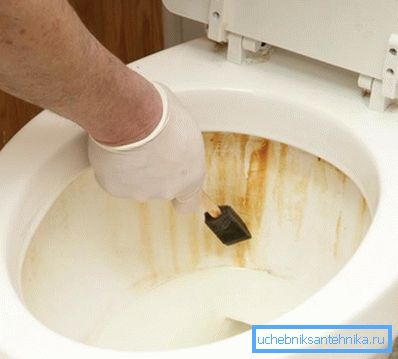
Cleaning the inner surface of the toilet bowl
The timely removal of lime and rusty deposits is not only aesthetic, but also of practical importance, since its rough surface is a favorable breeding ground for harmful bacteria that cause an unpleasant odor.
In order to make it easier for the reader to cope with this task, this article will provide detailed instructions describing several methods of dealing with a lime and rust deposit on the inner surface of household sanitary appliances.

Causes of rust
To effectively deal with any undesirable phenomenon, first of all, you need to find out and eliminate the cause of its occurrence, so before you get rid of rust in the toilet, you need to do so to minimize the possibility of its further occurrence.
- Formation of lime and rust deposits on the walls occurs only when the inner surface of the toilet bowl is in direct contact with water., therefore, the stop valve of the toilet cistern must be adjusted so that after filling it completely blocks the flow of water.
- In the case, valves and supply pipe of the drain tank there should be no elements or parts made of unprotected ferrous metala, which is prone to corrosion.
- Rough and porous surface contributes to enhanced formation of mineral deposits, therefore, you need to monitor the condition of the internal coating, protect it from scratches and chips, and carry out regular cleaning with household detergents.
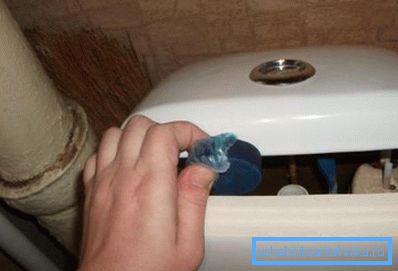
Tip! For the prevention of rust deposits, you can use special pills that periodically need to be invested in the drain tank. Dissolving in water, they give it a pleasant aroma, and also prevent the formation of lime and rusty deposits.
Chemical cleaners
The most effective and effective way to remove rust from ceramic and enamelled surfaces is the use of cleaning and detergent household industrial chemicals.
They differ in their composition, type of active substance, release form and consistency (liquid, gel or powder), and according to the principle of action they are divided into three groups:
- Alkaline compounds based on sodium hydroxide, which include the well-known “Domestos” product, are well suited for removing small rust deposits and dissolving fat deposits and organic human waste. In order to clean the toilet with your own hands, it is sufficient to evenly apply the product over the entire contaminated surface, and after 15-20 minutes rinse with cold water.
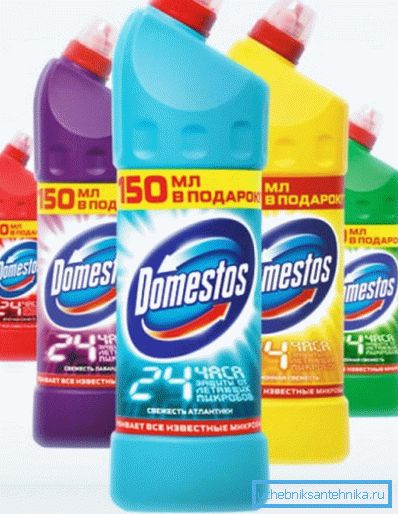
- Acidic household products based on hydrochloric acid, for example, Cillit, Sanitary Gel, or Toilet Duckling, are best suited for loosening and removing lime or rust on enamelled and ceramic surfaces. The method of application of such tools is similar to the above method of using alkaline compounds.
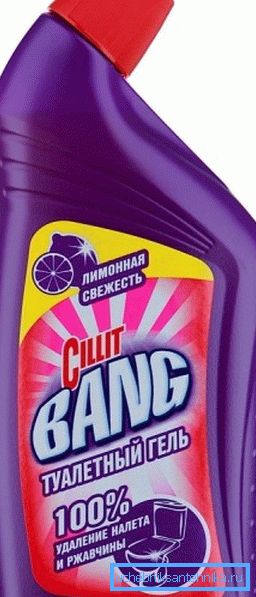
- Abrasive cleaners, better known under the trademarks Pemolyuks or Pemoksol, the price of which is the lowest among other products in this segment. They are a fine abrasive powder that must be applied to a wet surface and rubbed with a sponge or brush until all traces of contamination are completely eliminated. Such tools do well with most types of pollution, but at the same time, abrasive particles can cause scratches and microdamages on the outer surface of the sink or toilet bowl.

Tip! Due to the high corrosivity, acid and alkaline household chemicals are not recommended for cleaning unprotected metal surfaces.
Alternative rust removal methods
In addition to the presented detergents and cleaners, to remove rust stains, you can also use folk remedies, the constituent components of which can be found in a household chemical store or a first-aid kit.
- You can use hydrochloric or sulfuric (battery) acid to remove old stained spots. A small amount of reagent with a wet sponge should be evenly applied to the contaminated surface, and after 20 minutes, rinse with water.
- Minor contamination can be removed with vinegar, citric acid, as well as Coca-Cola or Sprite. To do this, it is necessary to moisten a dense cloth with them abundantly and put them to the place of pollution for 40-60 minutes, then rinse with water.
- Oxalic acid is also quite effective. A small amount of crystals should be poured on the sponge, and wipe the rust stains until they are completely removed.
- A gentle cleaning effect is exerted by a mixture of 100 ml of hydrogen peroxide and 5 g of ammonia. They need to be mixed in the specified proportion, and put on the contaminated place for 30-40 minutes.
- A good cleaning effect has a mixture of washing powder with chlorine bleach "Whiteness". Before you wash the toilet from rust, you need to remove all the water from it, apply the mixture to the inner surface and leave it overnight.
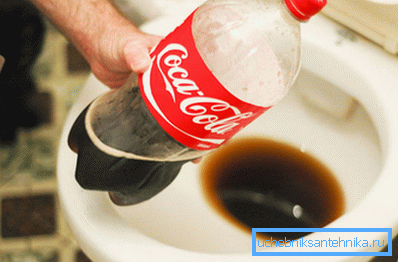
Conclusion
Finally, it should be remembered that all factory or self-made compounds, especially alkaline and acidic, are dangerous if they come into contact with the skin and mucous membranes of a person. For this reason, before washing the rust from the toilet bowl, you must use elemental personal protective equipment (rubber gloves, protective gloves). points). (See also the article How to clean a toilet from a stone: features.)
To learn more information on rust removal, you can watch the video in this article or read similar articles on our site.